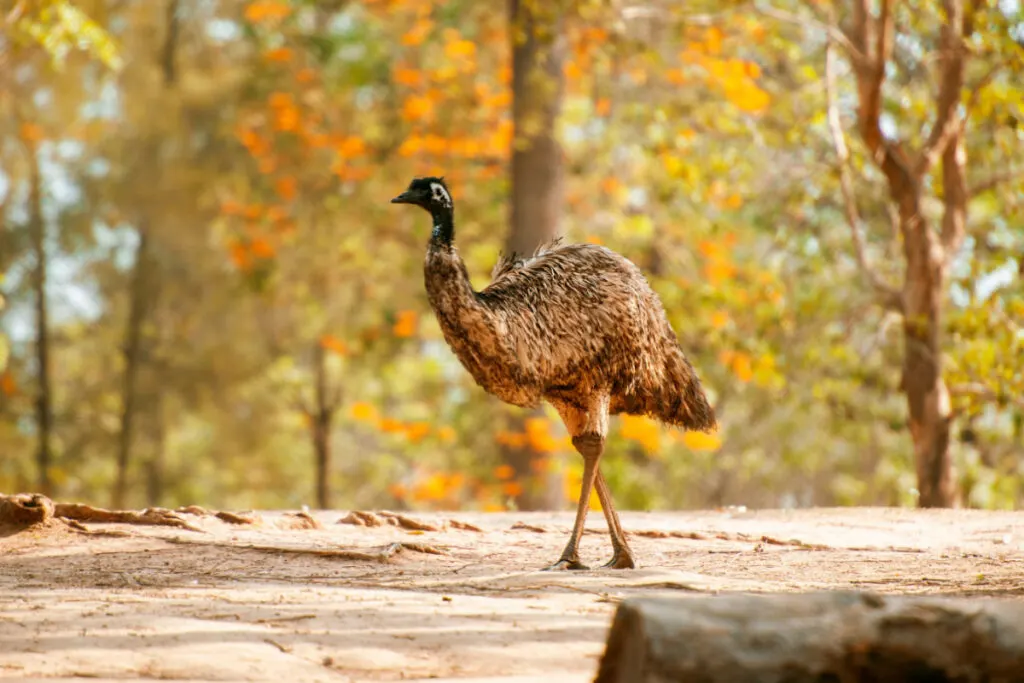Since emus are close relatives of ostriches, you would think emus can walk backward as ostriches can.
But is this really true? Can emus walk backwards?
Unlike ostriches, emus cannot walk backwards.
They share this inability to walk backwards with another Australian animal – kangaroos. Interestingly, kangaroos and emus are on the Australian coat of arms because they do not walk backward – perhaps, they signify progression.
While kangaroos avoid moving in reverse because of their tails, the exact reason for the inability of emus to move rearward is unknown.
What else is there that makes emus fascinating?
Table of Contents
15 Fun Facts
Now that you know emus cannot walk backwards, here are 15 other fun facts about emus:
Emus Are the Second-Largest Bird Alive
Behind their cousins, ostriches, emus are the second largest bird alive.
On average, emus grow to be as tall as 5.7 feet, and they weigh over 100 pounds. Plus, the length from an emu’s bill to its tail averages 5 feet.
Male emus are typically 110-120 pounds. But the females are usually up to 11 pounds heavier.
Emus Are the Only Birds With Calf Muscles
Of all the species of birds alive, emus are the only ones with calf muscles. The calf muscle (also known as gastrocnemius) is the largest leg muscle in emus.
It is thought that this muscle helps emus maintain their posture. It is also believed that the gastrocnemius promotes elastic energy retrieval and storage while emus run.

Emus Are Super Fast
Emus are amongst the top 3 fastest birds on land.
On land, ostriches might be the only birds faster than emus. On average, emus can run as fast as 31 miles per hour, while ostriches have an average speed of 43 miles per hour.
The speed of emus is, in part, due to their long legs and strong muscles. But beyond those features, the arrangement of the muscles and swinging parts of their legs helps them take rapid strides. Of course, their calf muscles also contribute to their superb speed.
Emu Wings Are Pretty Tiny
For birds that are the second-largest alive, emus have very tiny wings.
The wings of an emu measure around 7 to 8 inches. Their wings are smaller than the wings of a crow and about the size of a human hand.
It is thought that emu wings were not always as small as they are now. But possibly, the wings became progressively smaller as they had fewer reasons to fly.
Emus Cannot Fly
Emus cannot fly. Of course, this wouldn’t be much of a surprise after reading that emus have tiny wings.
In earlier times, emus could fly. But it is thought that the extinction of dinosaurs – their primary threat – contributed to their current flightlessness.
Without dinosaurs, there were no real threats to emus; they could easily outrun most threats. So, they didn’t need to fly as much. Then as time passed, their ability to fly became weaker until it possibly got removed from their gene pool.
While emu wings are not for flying, they have other roles. For one, when raised, emu wings help with cooling by promoting air circulation around the bodies of emus. Apart from that, emu wings help emus steer while running. The wings also help them maintain balance.
Emus Jump Very High
Besides being superb runners, emus are impressive jumpers. When these super-sized birds leap vertically, they can reach heights as high as 6.8 feet off the ground.
Each Stride of a Running Emu Is Longer Than the Average Human Height
While running, the stride of an emu can be as long as 9 feet. Of course, you know most humans do not grow as tall as 9 feet.

Emus Have Two Sets of Eyelids
Like ostriches, emus have multiple eyelids. But instead of 3 eyelids like ostriches, emus have 2 eyelids.
They blink with one of the eyelids and block dust out with the other.
A War Between Emus and Humans Ended in a Victory for Emus
In 1932, Australian troops battled a group of emus in Western Australia. Interestingly, the outcome was somewhat a victory for the emus.
The emus were said to have damaged a large area of cultivated wheat alongside the fences surrounding them. Of course, with the fence damaged, other animals got in and did more damage.
In response to the actions of the emus, the Australian military deployed troops with machine guns and 10,000 rounds.
After about 2 months of this “war” between Australian troops and emus, the troops abandoned the mission. They used over 10,000 rounds of ammo but killed less than 1000 emus. So, it was not worth it.
But while no human died in the encounter, it is said that the outgunned emus were victorious.
Male Emus Incubate Eggs and Raise Emu Chicks
During courtship, while female emus compete to get a mate, the males build the nests for the eggs. Then after mating, the females lay a clutch of eggs – typically 7 to 10 eggs.
On laying the eggs, the males sit on them for up to 8 weeks. While the males incubate the eggs, most female emus leave the territory to seek another mate. But some stay back to defend the males while they sit on the eggs.
When the eggs hatch, male emus become aggressive. They chase away the female emus in the territory and fend off any perceived threat. Then they stay with the chicks for about 2 years.
Male Emus Can Live Without Food for Up to 2 Months
While sitting on the eggs, male emus do not drink or eat. They remain in the nest throughout the incubation period, which lasts around 7 to 8 weeks. During incubation, male emus only move about 10 times a day, and they do this when they turn the eggs.
Since male emus do not eat or drink during the incubation period, they typically lose about 33% of their body weight.
Emus Have a Unique Voice
Emus have a deep voice with low frequency. Their voice, which sounds like a hollow drum, can be pretty loud. In fact, you can hear an emu’s voice from about 1.2 miles away.
While an emu’s voice is pretty loud, it is hard to record because of its low frequency.
Besides their usual sound, emus can whistle and grunt.

Emus Have Very Big Eggs
Emus may not lay the largest eggs in the world, but their eggs are pretty big. Emu eggs are around 5 to 6 inches long and about 3.5 inches wide. On average, they weigh about 1.5 pounds. But they can be as heavy as 2 pounds.
One emu egg is equivalent to about 10 chicken eggs. Contrarily, one ostrich egg is equivalent to roughly 2 emu eggs. The comparison between ostrich eggs and emu eggs is not surprising since ostriches are the biggest birds.
With one emu egg, you can make a big enough omelet to feed up to 6 human adults.
Emus Sometimes Swallow Small Stones to Aid Food Grinding
While eating, emus sometimes swallow small stones (around 0.1 lbs in weight) to aid food grinding. It appears that the stones are dissolved by gastric juices, so they don’t pose problems to the bird.
The Eyes of Emus Are Bigger Than Their Brains
Like ostriches, the eyes of emus are bigger than their brains.
Emus have eyes that measure around 2 inches in width. Yet, their brains are smaller than their eyes. Various suggestions point at the possibility of emus being one of the dumbest birds.
One study suggests that emus and parrots have the same brain-to-body ratio as when dinosaurs were around. Contrarily, the brains of some other birds – like crows and parrots – have evolved impressively over the same period.
Resources
- https://animals.mom.com/animals-cannot-walk-backwards-3794.html
- https://www.quora.com/Is-it-really-true-that-kangaroos-and-emus-cant-walk-backwards-hence-they-are-on-the-Australian-coat-of-arms-Is-there-science-behind-this-or-do-people-just-assume-they-cant-because-no-ones-ever-seen-one-do-it
- https://www.folly-farm.co.uk/zoo/meet-the-zoo-animals/emu/
- https://www.treehugger.com/emu-facts-5075359
- https://www.echidnawalkabout.com.au/5-amazing-facts-about-emu/
- https://animals.mom.com/size-emus-vs-ostriches-7605.html
- https://study.com/academy/answer/how-big-is-a-emu-egg.html
- https://books.google.com/books?id=kZqJAAAAQBAJ&pg=PA179
- https://www.nationalgeographic.com/animals/birds/facts/common-emu
- https://animals.sandiegozoo.org/animals/emu
- https://safarisafricana.com/fastest-birds-in-the-world/
- https://www.livescience.com/59822-fastest-animals.html
- https://zoodegranby.com/en/animals/emu
- https://journals.biologists.com/jeb/article/175/1/233/4853/STRUCTURAL-AND-METABOLIC-CHARACTERIZATION-OF-THE
- https://www.britannica.com/animal/emu
- https://nationalzoo.si.edu/animals/emu
- https://animals.mom.com/cant-emu-fly-7270.html
- https://www.dailymail.co.uk/sciencetech/article-8250015/Bird-brained-Parrots-crows-evolved-truly-exceptional-brain-sizes.html
- http://aviculturalsocietynsw.org/_articles/avian-intelligence.htm#.YbHt2NDMKMo
